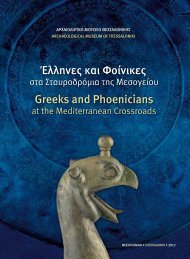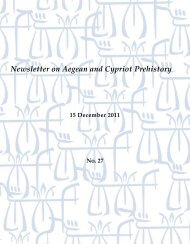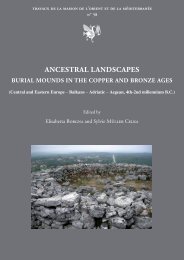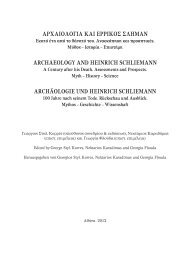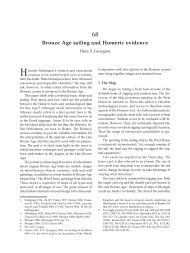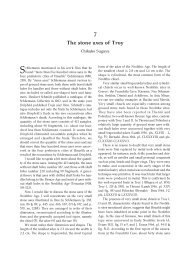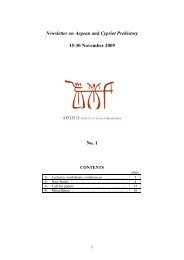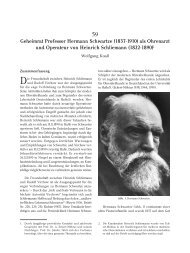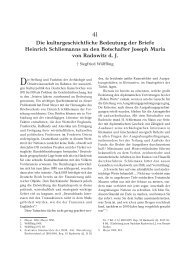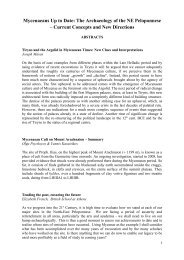MNEMONIC LANDSCAPES AND MONUMENTS OF THE PAST
MNEMONIC LANDSCAPES AND MONUMENTS OF THE PAST
MNEMONIC LANDSCAPES AND MONUMENTS OF THE PAST
Create successful ePaper yourself
Turn your PDF publications into a flip-book with our unique Google optimized e-Paper software.
224 y. galanakis<br />
reading the mnemonic landscape 18 – and by that, I refer to the embeddedness and mapping of memories on<br />
the landscape. That is to say that visibility from a distance may not have been as vital a characteristic as the<br />
positioning of the tombs in certain locations for fulfilling various goals and aspirations other than achieving<br />
physical prominence from afar. Therefore, we should try to avoid projecting our modern preconceived ideas<br />
about physical prominence onto the past, as landscape archaeology sometimes tends to do. We should also try<br />
to look beyond the practical parameters (e.g. proximity to arable land; water resources; or, as argued in this<br />
case, physical prominence in the landscape). In addition, mythological/cosmological landscapes in a microregional<br />
scale may have also played a prominent role in shaping the ways in which people approached and<br />
understood the visible as well as the invisible past. 19 The past is often mapped on the landscape – either as part<br />
of the landscape’s physical properties, or, more importantly, because of the interaction of people’s experiences<br />
and memories with it. In a sense, we should be looking for the “experienced” landscape where memories and<br />
emotions are combined.<br />
In their study on the location of Mycenaean tombs, Cavanagh and Mee concluded that the position of<br />
tombs within a territory does not appear to have been determined by any single factor. 20 Although appropriate<br />
geological conditions may have been sought after by the builders (especially for the construction of certain<br />
types of tombs, like the rock-cut chamber tombs), the position of the tomb was surely not dictated on<br />
grounds of geology alone. Several interpretations have been put forward in order to explain the placement<br />
of tombs, ranging from traditional and eschatological beliefs to territorial or social claims. 21 It appears<br />
that although some factors may have been more prominent than others, overall we should not expect a<br />
unifying element, a single answer, but should rather try to assess tombs and cemeteries in their own social,<br />
geographical and chronological context. This is not to say that the location they occupied was accidental<br />
or unimportant. On the contrary, tombs may have taken up a special place in the socio-political, natural or<br />
even eschatological landscape. In this respect location and associations rather than physical prominence<br />
may have been more important for the individuals that commissioned and interacted with these tombs.<br />
The “Palace of Nestor” at Ano Englianos (fig. 3)<br />
The well-surveyed, thoroughly studied and published site of Englianos provides us with an ideal case<br />
for exploring the factors that may have influenced the position of tombs in the landscape not least because<br />
it was the only site with early tholos tombs in the region to develop into a major administrative centre in<br />
Messenia in LH III based on the Linear B documents.<br />
In the late MBA to early LBA a fortification wall was built at the site around the highest point of<br />
the ridge, defining the area later to be occupied by palatial structures. 22 There is scarcely any evidence for<br />
structures of this phase beneath the later palatial remains, even after the recent detailed investigation of<br />
the available data by Nelson. 23 Despite the lack of evidence, it is significant that the north eastern sector<br />
of this circuit has an elaborate entranceway aligned directly on the stomion of tholos IV. 24 This alignment<br />
underlines vividly how certain individuals at Englianos may have decided to associate the settlement closely<br />
18. For mounds and monuments in general as focal points of memory and identity see Spencer 1995b; Bradley 1998; Bradley<br />
2002; Bailey 2000; Alcock 2002; van Dyke, Alcock 2003 (various articles); Papadopoulos et al. 2008 (with references);<br />
see also http://www.sscnet.ucla.edu/ioa/staff/ papadopoulos/lofkend/index.html (last accessed 10 February 2009), and<br />
Palumbi, this volume.<br />
19. Della Casa, this volume.<br />
20. Cavanagh, Mee 1990; Mee, Cavanagh 1990.<br />
21. See e.g. the recent study by Georgiadis and Gallou (2006-07) which highlights regional differences in the placement of<br />
the tombs in the landscape between the Argolid and the Dodecanese.<br />
22. Blegen et al. 1973, p. 4-18; Bennet 2007, p. 34.<br />
23. Nelson 2001.<br />
24. Blegen et al. 1973, p. 3, fig. 4; Davis 1998, p. 56; Bennet 2007, p. 34.



